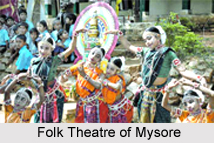 Folk theatre of Mysore expresses the best possible dramatic dances of the region. Among the dramatic dances of pre-integrated Mysore, Rangada Kunita, Nandikol Kunita, Vira Makkala Kunita, Virabhadrana Kunita, Garudi Bombe, Koldta and Mari Kunita are prominent. Among them the Kolata is the only community dance that has a group of chorus singers which resembles the chorus party of Bayalata.
Folk theatre of Mysore expresses the best possible dramatic dances of the region. Among the dramatic dances of pre-integrated Mysore, Rangada Kunita, Nandikol Kunita, Vira Makkala Kunita, Virabhadrana Kunita, Garudi Bombe, Koldta and Mari Kunita are prominent. Among them the Kolata is the only community dance that has a group of chorus singers which resembles the chorus party of Bayalata.
Virabhadrana Kunita
A colourful make-up and imposing costumes is the speciality of Virabhadrana Kunita, where the impersonator of Virabhadra with his red plait of hair, crown and bead necklaces receives devotion from his followers and dances vigorously, shouting songs and stories in praise of God Virabhadra. The beating-drum accompanies him as in all the other dramatic dances. The only folk mode which uses masks is Vira Makkala Kunita in which three or four performers put on masks that bear glaring expressions of pride, joy or valour and dance like warrior soldiers.
Garudi Bombe
Garudi Bombe is a huge bamboo structure in human form usually twelve feet in height, painted and dressed up as a man and woman. Such huge human figures which are light in weight are borne by individual performers who dance to the beating drum. Others are mostly community dances and remain dramatic because of their special costumes, music in chorus, dance in varying rhythms and symbolic gesture. In every dance it is "the sheer excitement of rhythm that caught their (performers) simple imagination and they were given that joy of their own strength and movement, the joy of creation. These ritual dances are essentially dramatic. The actor experiences a state of self-abandon and gets the joy and thrill of creating something in them, which is other than himself of communicating it to the audience and of dedicating the performance to Gods. In spite of the absence of the spoken word, these performances have the fundamentals of the folk theatre in their dance, music and gesture; but yet, they cannot assume the role of drama as they do not mean entertainment but aim at fulfilling a purpose or a commitment to the supernatural powers. In fact, the spectator himself is a performer in the majority of them. Yet, the dramatic dances, even without a regular theme, prose dialogues or organised method of presentation, do fulfil the essential purpose of the theatre by rousing a sentiment and creating a dreamland.




